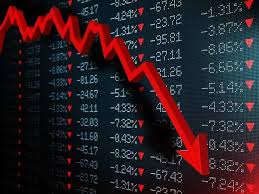Dollar firm but stocks, oil under pressure as U.S.-China tensions rise

The dollar rose, oil fell and stock markets were poised to slip on Monday as rising U.S.-China tensions over the coronavirus – and growing unease at the gulf between asset prices and grim economic reality – turned investors cautious.
A man wearing protective face mask, following an outbreak of the coronavirus disease (COVID-19), walks in front of a stock quotation board outside a brokerage in Tokyo, Japan, March 10, 2020. REUTERS/Stoyan Nenov/File Photo
In thin trade, with China and Japan on holiday, U.S. stock futures fell 1.6%, U.S. crude tumbled over $ 1 a barrel, or 6%, and futures for Australia’s benchmark ASX 200 index pointed to a negative open.
The safe-haven U.S. dollar rallied to one-week highs against the risk sensitive Australian and New Zealand dollars.
The moves extended a dour start to the month that began on Friday with bleak U.S. data and the threat of fresh trade-war hostilities between the world’s two biggest economies.
U.S. Secretary of State Mike Pompeo added to the jitters with remarks on Sunday, when he said there was “a significant amount of evidence” that the new coronavirus emerged from a Chinese laboratory.
Pompeo did not provide evidence, or dispute U.S. intelligence agencies’ conclusion that the virus was not man-made. But the comments double down on Washington’s pressure on China over the virus’ origin as U.S. deaths and economic damage mount.
A $ 50 billion dollar quarterly loss at Warren Buffett’s Berkshire Hathaway, and the legendary investor announcement that he had liquidated holdings in the four largest U.S. airlines also did little for investor confidence.
“The risk of a pullback has increased this week,” said Chris Weston, head of research at Melbourne brokerage Pepperstone.
“The United States is not alone in publicly taking aim at China, but whether it’s Trump, Kudlow or Pompeo the narrative is more frequent, and traders are selling yuan,” he said.
With onshore markets shut, the yuan extended Friday’s slump and fell about 0.2% to a six-week low of 7.1510 per dollar. The Australian dollar dropped below the 64-cent mark for the first time in a week, falling 0.5% to $ 0.6387.
The Korean won sat by a one-week low at 1,224.76 per dollar, after an exchange of gunfire between North Korea and South Korea at the Demilitarized Zone (DMZ) raised tensions, a day after North Korean state media reported Kim Jong Un’s first public appearance since April 11.
Elsewhere in currency markets, the Japanese yen was steady at 106.80 per dollar and the euro was a touch weaker at $ 1.0969. The pound and New Zealand dollar slipped.
In commodity markets, U.S. crude futures sank in early trade on worries about oil oversupply, even as some U.S. states and cities around the world start to ease coronavirus pandemic restrictions.
West Texas Intermediate crude futures last sat at $ 18.59 per barrel, down $ 1.19, while Brent futures were down 2.4%, or 64 cents, at $ 25.80.
U.S. manufacturing plunged to an 11-year low last month, consumer spending has collapsed and some 30.3 million Americans have filed claims for unemployment in the last six weeks.
“There is a sense of caution, if not foreboding as signs of economic weakness continue to emanate,” said Vishnu Varathan, head of economics and strategy at Mizuho Bank in Singapore.
“What’s really chilling is the risk that an almost quadrupling of unemployment to above 16% may prove sticky.”
The U.S. April jobs report will be released on Friday, but some analysts say it may not fully reflect how many people have been thrown out of work.

